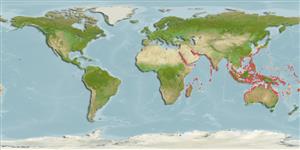Common names from other countries
>
Gobiiformes (Gobies) >
Gobiidae (Gobies) > Gobiinae
Etymology: Amblygobius: Greek, amblys = darkness + Latin gobius = gudgeon (Ref. 45335).
More on author: Rüppell.
Environment: milieu / climate zone / depth range / distribution range
Écologie
marin; saumâtre récifal; profondeur 10 - 20 m (Ref. 100374). Tropical; 22°C - 30°C (Ref. 27115)
Indo-West Pacific: Red Sea and East Africa south to Durban (South Africa), including most islands in the western Indian Ocean islands; Indonesia, Australia and South Pacific islands. Also known from Japan, Philippines (Ref. 2798) and Persian Gulf (Ref. 68964)
Taille / Poids / Âge
Maturity: Lm ? range ? - ? cm
Max length : 18.0 cm SL mâle / non sexé; (Ref. 2798)
Description synthétique
Clés d'identification | Morphologie | Morphométrie
Épines dorsales (Total) : 7; Rayons mous dorsaux (Total) : 13 - 15; Épines anales: 1; Rayons mous anaux: 12 - 14. Males with 3 black spots near base of 2nd dorsal fin and round spots on cheek; females with brown-edged band from upper lip to upper operculum (Ref. 2798).
Epibenthic and littoral, entering estuaries and lagoons (Ref. 4343). Usually seen in pairs, hovering a short distance above the substratum. Monogamous (Ref. 52884). t builds its burrow in sand or silty sand by moving out mouthfuls of sediment (Ref. 11441). Maximum depth reported taken from Ref. 9773.
Life cycle and mating behavior
Maturities | Reproduction | Spawnings | Egg(s) | Fecundities | Larves
Monogamous mating is observed as both obigate and social (Ref. 52884).
Maugé, L.A., 1986. Gobiidae. p. 358-388. In J. Daget, J.-P. Gosse and D.F.E. Thys van den Audenaerde (eds.) Check-list of the freshwater fishes of Africa (CLOFFA). ISNB, Brussels; MRAC, Tervuren; and ORSTOM, Paris. Vol. 2. (Ref. 4343)
Statut dans la liste rouge de l'IUCN (Ref. 130435)
CITES (Ref. 128078)
Not Evaluated
Menace pour l'homme
Harmless
Utilisations par l'homme
Pêcheries: commercial; Aquarium: Commercial
Outils
Articles particuliers
Télécharger en XML
Sources Internet
Estimates based on models
Preferred temperature (Ref.
115969): 24.6 - 29.3, mean 28.4 (based on 3100 cells).
Phylogenetic diversity index (Ref.
82804): PD
50 = 0.5000 [Uniqueness, from 0.5 = low to 2.0 = high].
Bayesian length-weight: a=0.01023 (0.00477 - 0.02194), b=3.02 (2.84 - 3.20), in cm Total Length, based on LWR estimates for this (Sub)family-body shape (Ref.
93245).
Niveau trophique (Ref.
69278): 3.3 ±0.06 se; based on food items.
Résilience (Ref.
120179): Milieu, temps minimum de doublement de population : 1,4 à 4,4 années (Preliminary K or Fecundity.).
Fishing Vulnerability (Ref.
59153): Low vulnerability (12 of 100).
